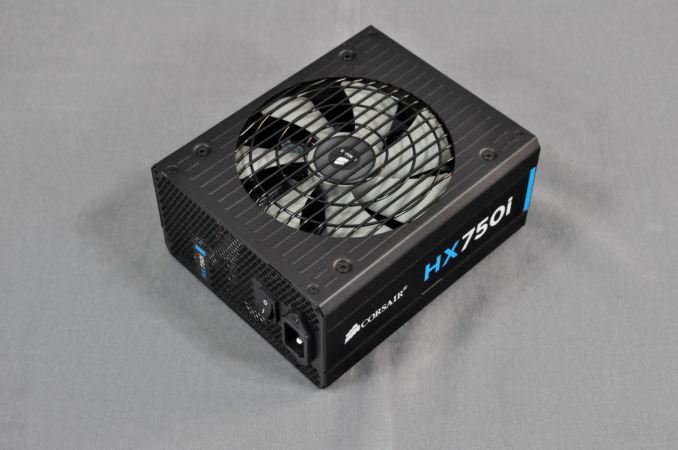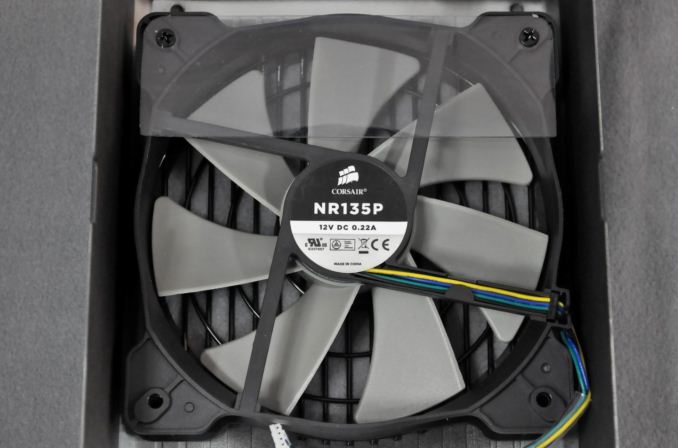Corsair HX750i Power Supply Review
by E. Fylladitakis on January 14, 2015 10:00 AM EST- Posted in
- Cases/Cooling/PSUs
- Corsair
- PSUs
- HXi Series
External Appearance
Visually, the Corsair HX750i stands out from the crowd. It's housed in a 180mm long chassis, which is considerably longer than a standard ATX chassis. Such a long chassis could be a problem in compact cases designs but it is not likely that any modern ATX tower case would not have enough space to accommodate the HX750i. The body has been sprayed with a satin black paint and decorative stickers cover the largest portion of its two sides. Further aesthetic improvements include chamfered edges and embossed parallel ridges aligned with the fan's finger guard design. The sticker with the specifications of the PSU can be found on the top of the chassis (opposite the fan).
The front of the chassis is littered with the connectors for the modular cables. The CPU and PCI Express cables share the same connectors, while the split 10-14 pin connector is for the 24-pin ATX cable and the smaller connectors are for SATA/Molex cables. There are also two connectors for the Corsair Link interface, one Mini-USB for direct connection to an internal USB header or a four-pin PMBus cable for connection to a Commander unit.
Internal Design
A grey blade 135mm fan takes care of the cooling that the HX750i requires at higher loads. At lower loads and depending on the temperature, the fan of the HX750i will not operate at all. It has a rifle bearing and a maximum speed of about 1600 RPM. With the UL number pointing back to Corsair, we cannot identify the OEM of the fan, as Corsair appears to be the manufacturer of these fans.
The interior of the HX750i is where things become truly interesting. The HX750i is based on a Channel Well Technologies (CWT) design, a company that goes way back with Corsair and who built many of their earlier units. It is also nearly identical with the platform used for the RM series. The heatsinks are not much more than simple quadrangular metallic slabs with minimal heat dissipation surface, but they ought to be adequate for the cooling needs of the very efficient HX750i, especially since the same heatsinks were enough for the RM1000.
The 400V / 390μF APFC capacitors are supplied by Nippon Chemi-Con, as is every other electrolytic capacitor inside the HX750i. The polymer capacitors come from Apaq, a Taiwanese manufacturer. The quality of the components appears to be the only major improvement over the RM series, in which we found components mainly from Taiwanese manufacturers instead. The filtering stage begins at the back of the AC receptacle, where we found two of the Y capacitors. There are a total of six Y capacitors, three X capacitors, and two filtering inductors -- a reasonable amount of components for a good filtering stage.
As far as the build quality goes, CWT did a magnificent job with the HX750i. The soldering job is excellent, competing with the best that we have ever seen. If not for a little excessive use of solder at a few points, it would grade as immaculate. The factory used a lot of glue to secure most components, improving the mechanical cohesion of the unit. An extra application of lacquer and glue can be seen on the inductors, as well as heatshrink/tape covering, most likely to minimize the chance of vibration-generated noise (also known as "coil whine").
























32 Comments
View All Comments
HollyDOL - Wednesday, January 14, 2015 - link
Please note at what input voltage were the conversion losses and efficiency measured... Usualy 230V tends to be about 2% better than 115V...patrioteagle07 - Wednesday, January 14, 2015 - link
Yup... subpar review... I don't know what I am looking at here.Meaker10 - Wednesday, January 14, 2015 - link
Would help if you read their link on how they measure power supplies rather than repeating it in every article:"Cold Test Results
For testing PSUs, we use high precision electronic loads with a maximum power draw of 2700 Watts, a Rigol DS5042M 40 MHz oscilloscope, an Extech 380803 power analyzer, two high precision UNI-T UT-325 digital thermometers, an Extech HD600 SPL meter, a self-designed hotbox, and various other bits and parts. For a thorough explanation of our testing methodology and more details on our equipment, please refer to our How We Test PSUs – 2014 Pipeline post."
(The article links it in the text) they state:
"Our Extech 380803 power analyzer does a very good job at reporting the level of power that our PSU requires at any given time. We should note that all testing is being performed with a 230V/50Hz input, delivered by a 3000VA VARIAC for the perfect adjustment of the input voltage. Unfortunately, we cannot perform tests at 110V/60Hz at the moment, as that requires a high output, programmable AC power source. As a rough estimate, conversion efficiency drops by 1% to 1.5% when the input voltage is lowered to 110V/ 60Hz."
So try reading a bit.
Samus - Wednesday, January 14, 2015 - link
"It appears that Corsair shot themselves in the foot, as there is no reason not to prefer the AX760i to the HX750i, not even if the AX760i is selling at $184 without any rebate, let alone while it is cheaper than the HX750i."This is what happens when you saturate your lineup. Corsair, stop making so many god damn PSU's. You only need 3-4 Categories (80 Plus Bronze, Silver, Gold...and perhaps Platinum) and only a few models in each category. They shouldn't be dividing up the models by modular or fixed cables, either, since this creates inconsistency within the category (the modular category has various 80 Plus ratings!)
For the 80 Plus Bronze: 400, 550, 650 watt
For the 80 Plus Silver: 400, 600, 750
For the 80 Plus Gold: 550, 750, 900, 1200
For the 80 Plus Platinum: 500, 650, 800, 1000
Currently, their lineup is:
http://www.corsair.com/en-us/power-supply-units
They have 8 categories with a dozen products or so in EACH of them. I don't even understand why they have non-80 plus (VS series) products being that they want a reputation of delivering high quality products.
I didn't go to school for marketing, so I'm not an expert at this...but I question whether Corsair's marketing department went to school for marketing...their product lineup is all over the place and there is no consistency.
just4U - Wednesday, January 14, 2015 - link
I'd say cut the silver out all together. Not that it matters Corsair has gotten silly with PSU pricing anyway. Their value lineup is ok but once you hit the $100 mark and on up there are very good alternatives that corsair isn't matching price wise.Lukeroge - Thursday, January 15, 2015 - link
Honestly, AXi (aside from 1500i, which is newer) is worse. It has a pretty cheap mediocre fan, and many units have an issue where the fan makes a tapping sound every 13 seconds at idle. I returned my AX760i and swapped it for an HX850iStrangerGuy - Thursday, January 15, 2015 - link
This particular model that is being reviewed cost a flippin' 140 bucks at Newgg. Do they even know how much better stuff competitors offers at $140? 850W Evga G2 made by the best consumer level PSU OEM, Superflower.AnnonymousCoward - Thursday, January 15, 2015 - link
Love the revieweanazag - Friday, January 16, 2015 - link
I'm not aware of what the Corsair link USB junk does. It would help to cover that as it is a feature that not all PS's have. I'm suspecting it has been covered before in another article; linking that other article would work for me.Another thing I look for in power supplies is if it has two 8 pin 12V ATX CPU cables. Usually it is one 8 plus a 4+4 providing the second 8. This matters if you're going to be able to hook it up to a 2P board for servers. I like to buy power supplies I can use in a desktop or server. This feature can end up costing more like in the Antec HC gamer vs. HC Pro PS's. The Antec gamer lacks this, while the Pro is sporting it.
DanNeely - Saturday, January 17, 2015 - link
Some high end desktop boards are doing 8+4 or 8+4+6 as well; unless you normally replace your PSU with each build, it's something I'd recommend getting when specing out a new PSU for a high end enthusiast system.